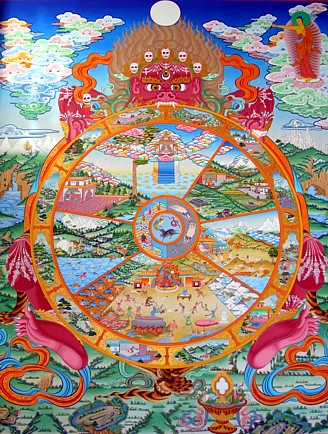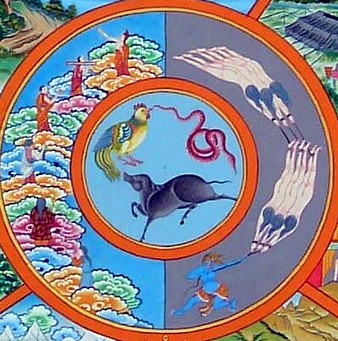Wheel of Life

Wheel of Life (Skt. bhavacakra; Wyl. srid pa'i 'khor lo) - a traditional representation of the samsaric cycle of existence.
Overview
The Wheel of Life is a traditional representation of the samsaric cycle of existence. In brief:
- The center of the wheel represents the three poisons.
- The second layer represents positive and negative actions, or karma.
- The third layer represents the six realms of samsara.
- The fourth layer represents the twelve links of interdependent origination.
- The monster holding the wheel represents impermanence.
- The moon above the wheel represents liberation from the samsaric cycle of existence.
- The Buddha pointing to the moon indicates that liberation is possible.
The Dalai Lama writes:
- Symbolically [the inner] three circles, moving from the center outward, show that the three afflictive emotions[1] of desire, hatred, and ignorance give rise to virtuous and non-virtuous actions, which in turn give rise to levels of suffering in cyclic existence. The outer rim symbolizing the twelve links of dependent arising indicates how the sources of suffering--actions and afflictive emotions--produce lives within cyclic existence. The fierce being holding the wheel symbolizes impermanence... The moon [at the top] indicates liberation. The Buddha on the left is pointing to the moon, indicating that liberation that causes one to cross the ocean of suffering of cyclic existence should be actualized.[2]
Dzongsar Khyentse Rinpoche writes:
- One of the reasons why the Wheel of Life was painted outside the monasteries and on the walls (and was really encouraged even by the Buddha himself) is to teach this very profound Buddhist philosophy of life and perception to more simple-minded farmers or cowherds. So these images on the Wheel of Life are just to communicate to the general audience.[3]
Center of the Wheel: The Three Poisons

Ringu Tulku Rinpoche said:
- Tibetans have a traditional painting called the Wheel of Life, which depicts the samsaric cycle of existence. In the center of this wheel are three animals: a pig, a snake, and a bird. They represent the three poisons. The pig stands for ignorance, although a pig is not necessarily more stupid than other animals. The comparison is based on the Indian concept of a pig being the most foolish of animals, since it always sleeps in the dirtiest places and eats whatever comes to its mouth. Similarly, the snake is identified with anger because it will be aroused and leap up at the slightest touch. The bird represents desire and clinging. In Western publications it is frequently referred to as a cock, but this is not exactly accurate. This particular bird does not exist in Western countries, as far as I know. It is used as a symbol because it is very attached to it's partner. These three animals represent the three main mental poisons, which are the core of the Wheel of Life. Stirred by these, the whole cycle of existence evolves. Without them, there is no samsara.[4]
Second Layer: Positive and Negative Actions
The images in this layer vary in different paintings of the wheel. In the image shown here, the two half circles represent positive and negative actions, or karma, that are motivated by the three poisons of ignorance, attachment/desire and aversion/hatred.
- The half-circle on the right shows positive or virtuous actions. Such actions are the means for attaining lives in the three higher realms of the gods, demi-gods and humans.
- The half-circle on the left shows negative or non-virtuous actions. Such actions are the means for attaining lives in the three lower realms of the animals, hungry ghosts and hell-beings.
Third Layer: Six Realms of Samsara
The third layer of the wheel depicts the six realms of samsara.
Fourth Layer: Twelve Links
The fourth layer of the wheel depicts the twelve links of interdependent origination.
The Monster Holding the Wheel: Impermanence
Jeffrey Hopkins writes:
- The wheel in the center of the painting is in the grasp of a frightful monster. This signifies that the entire process of cyclic existence is caught within transience. Everything in our type of life is characterized by impermanence. Whatever is built will fall down, whatever and whoever come together will fall apart.[5]
The Dalai Lama writes:
- The fierce being holding the wheel symbolizes impermanence, which is why the being is a wrathful monster, though there is no need for it to be drawn with ornaments and so forth... Once I had such a painting drawn with a skeleton rather than a monster, in order to symbolize impermanence more clearly.[6]
Reflecting on impermanence can start us on the path towards liberation.
Sogyal Rinpoche writes:
- The Western poet Rainer Maria Rilke has said that our deepest fears are like dragons guarding our deepest treasure. The fear that impermanence awakens in us, that nothing is real and nothing lasts, is, we come to discover, our greatest friend because it drives us to ask: If everything dies and changes, then what is really true? Is there something behind the appearances, something boundless and infinitely spacious, something in which the dance of change and impermanence takes place? Is there something in fact we can depend on, that does survive what we call death?
- Allowing these questions to occupy us urgently, and reflecting on them, we slowly find ourselves making a profound shift in the way we view everything. With continued contemplation and practice in letting go, we come to uncover in ourselves "something" we cannot name or describe or conceptualize, "something" that we begin to realize lies behind all the changes and deaths of the world. The narrow desires and distractions to which our obsessive grasping onto permanence has condemned us begin to dissolve and fall away.
- As this happens we catch repeated and glowing glimpses of the vast implications behind the truth of impermanence. It is as if all our lives we have been flying in an airplane through dark clouds and turbulence, when suddenly the plane soars above these into the clear, boundless sky. Inspired and exhilarated by this emergence into a new dimension of freedom, we come to uncover a depth of peace, joy, and confidence in ourselves that fills us with wonder, and breeds in us gradually a certainty that there is in us "something" that nothing destroys, that nothing alters, and that cannot die. Milarepa wrote:
- In horror of death, I took to the mountains--<br\>Again and again I meditated on the uncertainty of the hour of death, <br\>Capturing the fortress of the deathless unending nature of mind. <br\>Now all fear of death is over and done.
- Gradually, then, we become aware in ourselves of the calm and sky-like presence of what Milarepa calls the deathless and unending nature of mind.
- And as this new awareness begins to become vivid and almost unbroken, there occurs what the Upanishads call “a turning about in the seat of consciousness,” a personal, utterly non-conceptual revelation of what we are, why we are here, and how we should act, which amounts in the end to nothing less than a new life, a new birth, almost, you could say, a resurrection.
- What a beautiful and what a healing mystery it is that from contemplating, continually and fearlessly, the truth of change and impermanence, we come slowly to find ourselves face to face, in gratitude and joy, with the truth of the changeless, with the truth of the deathless, unending nature of mind![7]
Internal Links
Further Reading
- Dzongsar Khyentse Rinpoche, Gentle Voice #22, September 2004 Issue
- Ringu Tulku, Daring Steps Toward Fearlessness: The Three Vehicles of Tibetan Buddhism, Snow Lion, 2005
- The Dalai Lama, The Meaning of Life, translated and edited by Jeffrey Hopkins, Boston: Wisdom, 1992
Notes
- ↑ An alternate translation of the three poisons.
- ↑ The Dalai Lama, The Meaning of Life, translated and edited by Jeffrey Hopkins, Boston: Wisdom, 1992, page 42.
- ↑ Dzongsar Khyentse Rinpoche, Gentle Voice #22, September 2004 Issue, page 3.
- ↑ Ringu Tulku, Daring Steps Toward Fearlessness: The Three Vehicles of Tibetan Buddhism, Snow Lion, 2005 page 30.
- ↑ The Dalai Lama, The Meaning of Life, translated and edited by Jeffrey Hopkins, Boston: Wisdom, 1992, page 3.
- ↑ The Dalai Lama, The Meaning of Life, translated and edited by Jeffrey Hopkins, Boston: Wisdom, 1992, page 42.
- ↑ Sogyal Rinpoche, The Tibetan Book of Living and Dying, Harper San Francisco, 2002, page 39.